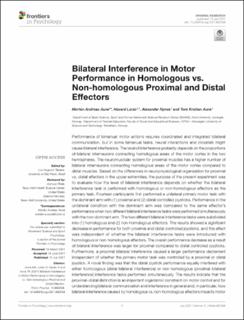| dc.contributor.author | Aune, Morten Andreas | |
| dc.contributor.author | Lorås, Håvard | |
| dc.contributor.author | Nynes, Aleksander | |
| dc.contributor.author | Aune, Tore Kristian | |
| dc.date.accessioned | 2021-08-31T08:34:45Z | |
| dc.date.available | 2021-08-31T08:34:45Z | |
| dc.date.created | 2021-07-12T12:57:11Z | |
| dc.date.issued | 2021 | |
| dc.identifier.citation | Frontiers in Psychology. 2021, 12, 1-11. | en_US |
| dc.identifier.issn | 1664-1078 | |
| dc.identifier.uri | https://hdl.handle.net/11250/2771871 | |
| dc.description.abstract | Performance of bimanual motor actions requires coordinated and integrated bilateral communication, but in some bimanual tasks, neural interactions and crosstalk might cause bilateral interference. The level of interference probably depends on the proportions of bilateral interneurons connecting homologous areas of the motor cortex in the two hemispheres. The neuromuscular system for proximal muscles has a higher number of bilateral interneurons connecting homologous areas of the motor cortex compared to distal muscles. Based on the differences in neurophysiological organization for proximal vs. distal effectors in the upper extremities, the purpose of the present experiment was to evaluate how the level of bilateral interference depends on whether the bilateral interference task is performed with homologous or non-homologous effectors as the primary task. Fourteen participants first performed a unilateral primary motor task with the dominant arm with (1) proximal and (2) distal controlled joysticks. Performance in the unilateral condition with the dominant arm was compared to the same effector’s performance when two different bilateral interference tasks were performed simultaneously with the non-dominant arm. The two different bilateral interference tasks were subdivided into (1) homologous and (2) non-homologous effectors. The results showed a significant decrease in performance for both proximal and distal controlled joysticks, and this effect was independent of whether the bilateral interference tasks were introduced with homologous or non-homologous effectors. The overall performance decrease as a result of bilateral interference was larger for proximal compared to distal controlled joysticks. Furthermore, a proximal bilateral interference caused a larger performance decrement independent of whether the primary motor task was controlled by a proximal or distal joystick. A novel finding was that the distal joystick performance equally interfered with either homologous (distal bilateral interference) or non-homologous (proximal bilateral interference) interference tasks performed simultaneously. The results indicate that the proximal–distal distinction is an important organismic constraint on motor control and for understanding bilateral communication and interference in general and, in particular, how bilateral interference caused by homologous vs. non-homologous effectors impacts motor performance for proximal and distal effectors. The results seem to map neuroanatomical and neurophysiological differences for these effectors. | en_US |
| dc.language.iso | eng | en_US |
| dc.publisher | Frontiers Media | en_US |
| dc.rights | Navngivelse 4.0 Internasjonal | * |
| dc.rights.uri | http://creativecommons.org/licenses/by/4.0/deed.no | * |
| dc.title | Bilateral Interference in Motor Performance in Homologous vs. Non-homologous Proximal and Distal Effectors | en_US |
| dc.type | Peer reviewed | en_US |
| dc.type | Journal article | en_US |
| dc.description.version | publishedVersion | en_US |
| dc.source.pagenumber | 1-11 | en_US |
| dc.source.volume | 12 | en_US |
| dc.source.journal | Frontiers in Psychology | en_US |
| dc.identifier.doi | 10.3389/fpsyg.2021.680268 | |
| dc.identifier.cristin | 1921498 | |
| dc.description.localcode | Copyright © 2021 Aune, Lorås, Nynes and Aune. This is an open-access article distributed under the terms of the Creative Commons Attribution License (CC BY). The use, distribution or reproduction in other forums is permitted, provided the original author(s) and the copyright owner(s) are credited and that the original publication in this journal is cited, in accordance with accepted academic practice. No use, distribution or reproduction is permitted which does not comply with these terms. | en_US |
| dc.source.articlenumber | 680268 | en_US |
| cristin.ispublished | true | |
| cristin.fulltext | original | |
| cristin.qualitycode | 1 | |

